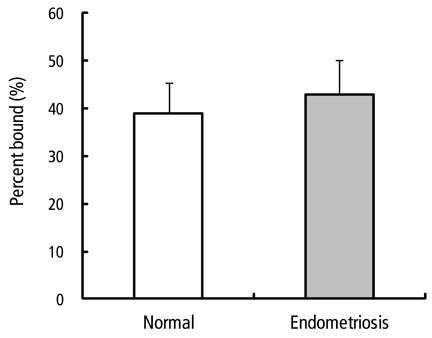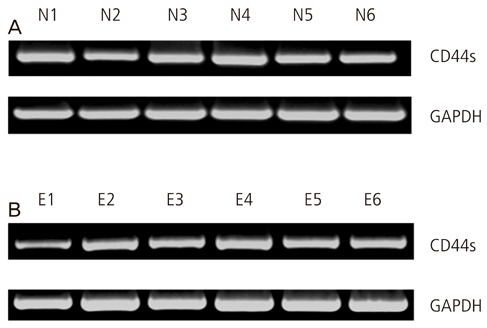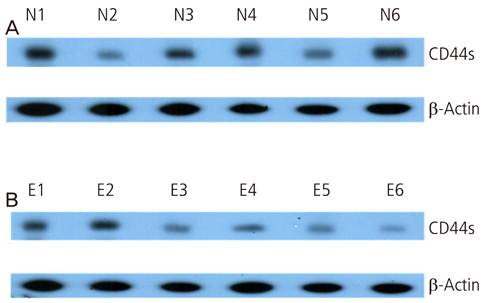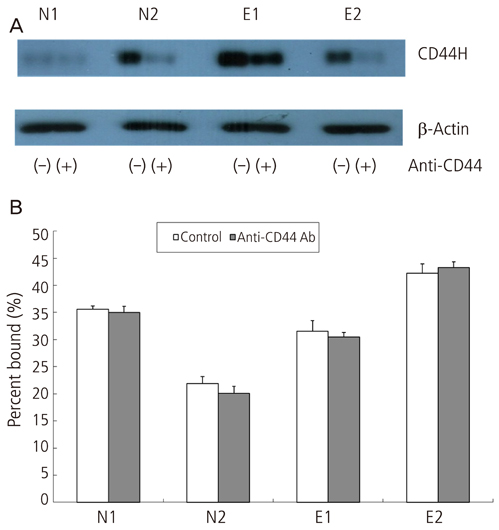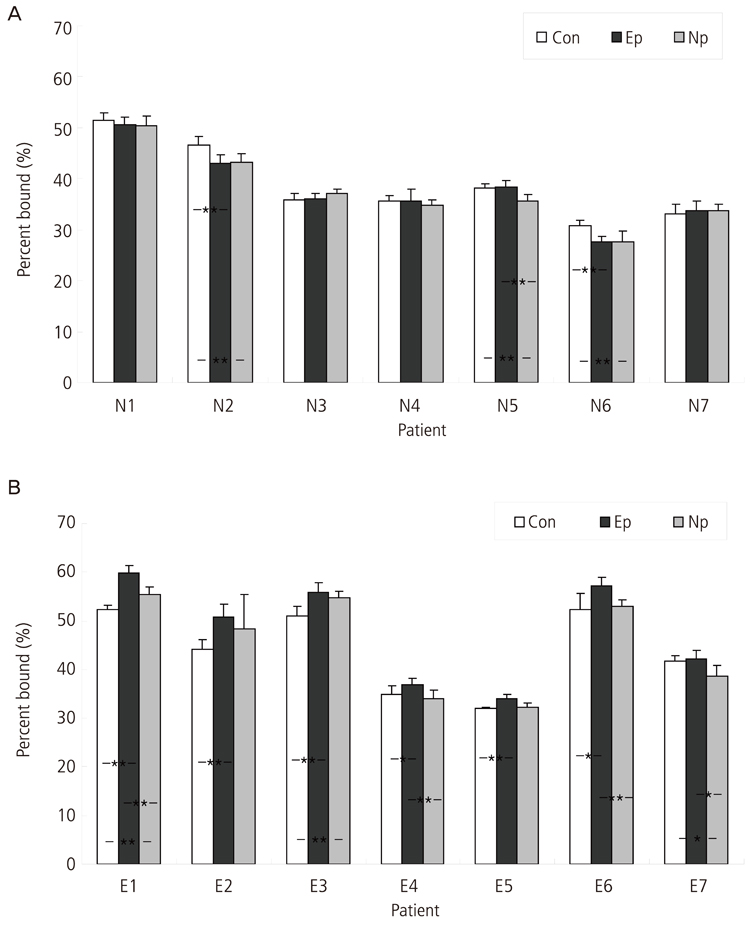Obstet Gynecol Sci.
2013 Mar;56(2):102-109. 10.5468/OGS.2013.56.2.102.
Expression of CD44 in endometrial stromal cells from women with and without endometriosis and its effect on the adherence to peritoneal mesothelial cells
- Affiliations
-
- 1Department of Obstetrics and Gynecology, Pusan National University Yangsan Hospital, Yangsan, Korea. yjna@pusan.ac.kr
- 2Department of Obstetrics and Gynecology, Pusan National University College of Medicine, Busan, Korea.
- KMID: 1425657
- DOI: http://doi.org/10.5468/OGS.2013.56.2.102
Abstract
OBJECTIVE
This study was performed to compare the expression of CD44 in endometrial stromal cells (ESCs) of women with and without endometriosis and to evaluate the role of CD44 in the adherence of ESCs to peritoneal mesothelial cells (PMCs).
METHODS
A PMC adherence assay was performed to evaluate the adherence of ESCs to PMCs in women with and without endometriosis. The expression of CD44 mRNA was measured by reverse transcription-polymerase chain reaction. CD44 protein was evaluated by Western blot analysis.
RESULTS
There were no significant differences in the expression of CD44 mRNA and protein in ESCs or in the binding of ESCs to PMCs between patients with endometriosis and controls. Although the expression of CD44 protein was decreased in both women with endometriosis and controls after anti-CD44 antibody treatment, there was no effect on binding of ESCs to PMCs. Treatment of ESCs with peritoneal fluid from endometriosis patients resulted in a significant increase in binding of ESCs to PMCs compared to untreated ESCs in the endometriosis group.
CONCLUSION
This study demonstrates that the expression of CD44 protein in ESCs from women with endometriosis might not be directly associated with adherence to PMCs.
MeSH Terms
Figure
Reference
-
1. Giudice LC, Kao LC. Endometriosis. Lancet. 2004. 364:1789–1799.2. Berkkanoglu M, Arici A. Immunology and endometriosis. Am J Reprod Immunol. 2003. 50:48–59.3. Sharpe-Timms KL. Endometrial anomalies in women with endometriosis. Ann N Y Acad Sci. 2001. 943:131–147.4. Lucidi RS, Witz CA, Chrisco M, Binkley PA, Shain SA, Schenken RS. A novel in vitro model of the early endometriotic lesion demonstrates that attachment of endometrial cells to mesothelial cells is dependent on the source of endometrial cells. Fertil Steril. 2005. 84:16–21.5. Cannistra SA, Kansas GS, Niloff J, DeFranzo B, Kim Y, Ottensmeier C. Binding of ovarian cancer cells to peritoneal mesothelium in vitro is partly mediated by CD44H. Cancer Res. 1993. 53:3830–3838.6. Lessan K, Aguiar DJ, Oegema T, Siebenson L, Skubitz AP. CD44 and beta1 integrin mediate ovarian carcinoma cell adhesion to peritoneal mesothelial cells. Am J Pathol. 1999. 154:1525–1537.7. Naor D, Sionov RV, Ish-Shalom D. CD44: structure, function, and association with the malignant process. Adv Cancer Res. 1997. 71:241–319.8. Albers A, Thie M, Hohn HP, Denker HW. Differential expression and localization of integrins and CD44 in the membrane domains of human uterine epithelial cells during the menstrual cycle. Acta Anat (Basel). 1995. 153:12–19.9. Prifti S, Sillem M, Arslic T, Monga B, Rehberger S, Runnebaum B. In vitro expression of soluble and cell surface-associated CD44 on endometrial cells from women with and without endometriosis. Eur J Clin Invest. 1998. 28:1055–1060.10. Saegusa M, Hashimura M, Okayasu I. CD44 expression in normal, hyperplastic, and malignant endometrium. J Pathol. 1998. 184:297–306.11. Behzad F, Seif MW, Campbell S, Aplin JD. Expression of two isoforms of CD44 in human endometrium. Biol Reprod. 1994. 51:739–747.12. Yaegashi N, Fujita N, Yajima A, Nakamura M. Menstrual cycle dependent expression of CD44 in normal human endometrium. Hum Pathol. 1995. 26:862–865.13. Kirk D, Irwin JC. Normal human endometrium in cell culture. Methods Cell Biol. 1980. 21B:51–77.14. Osteen KG, Hill GA, Hargrove JT, Gorstein F. Development of a method to isolate and culture highly purified populations of stromal and epithelial cells from human endometrial biopsy specimens. Fertil Steril. 1989. 52:965–972.15. Pierro E, Minici F, Alesiani O, Miceli F, Proto C, Screpanti I, et al. Stromal-epithelial interactions modulate estrogen responsiveness in normal human endometrium. Biol Reprod. 2001. 64:831–838.16. Screaton GR, Bell MV, Bell JI, Jackson DG. The identification of a new alternative exon with highly restricted tissue expression in transcripts encoding the mouse Pgp-1 (CD44) homing receptor. Comparison of all 10 variable exons between mouse, human, and rat. J Biol Chem. 1993. 268:12235–12238.17. Griffith JS, Liu YG, Tekmal RR, Binkley PA, Holden AE, Schenken RS. Menstrual endometrial cells from women with endometriosis demonstrate increased adherence to peritoneal cells and increased expression of CD44 splice variants. Fertil Steril. 2010. 93:1745–1749.18. Afify AM, Craig S, Paulino AF. Temporal variation in the distribution of hyaluronic acid, CD44s, and CD44v6 in the human endometrium across the menstrual cycle. Appl Immunohistochem Mol Morphol. 2006. 14:328–333.19. Gardner MJ, Catterall JB, Jones LM, Turner GA. Human ovarian tumour cells can bind hyaluronic acid via membrane CD44: a possible step in peritoneal metastasis. Clin Exp Metastasis. 1996. 14:325–334.20. Wu MY, Ho HN. The role of cytokines in endometriosis. Am J Reprod Immunol. 2003. 49:285–296.21. Harada T, Iwabe T, Terakawa N. Role of cytokines in endometriosis. Fertil Steril. 2001. 76:1–10.
- Full Text Links
- Actions
-
Cited
- CITED
-
- Close
- Share
- Similar articles
-
- Inhibitory effect of Nitric oxide on the Proliferation of Endometrial cells
- Effects of simvastatin on the proliferation and apoptosis of human endometrial stromal cells from women with endometriosis
- The effects of insulin-like growth factors on the proliferation of endometrial stromal cells from patients with and without endometriosis
- Effects of Insulin-like Growth Factor in Peritoneal Fluid of Patients with Endometriosis on the Proliferation of Endometrial Stromal Cells
- Cultivation of the Isolated Bovine Endometrial Stromal Cells and the Effect of Interleukin - 2 on Its Proliferation

